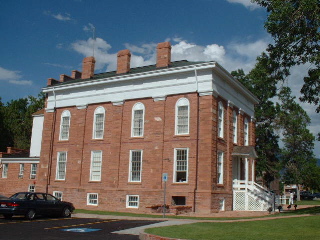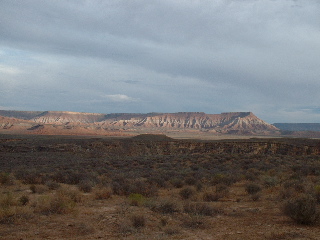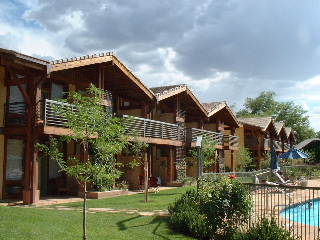
Provincial Capitol at Fillmore, Utah.
Day-by-Day |
|
| Introduction | |
| Travel | |
| Zion National Park | |
| Bryce National Park | |
| Zion National Park | |
| Coral Pink Dunes, Cedar Breaks and the Vermilion Cliffs | |
| Grand Canyon North Rim | |
| Antelope Canyon and Lake Powell | |
| Navajo National Monument, Monument Valley, and Natural Bridges | |
| Arches National Park | |
| Canyonlands National Park | |
| Arches and the Drive to Park City | |
| Utah Olympic Park | |
| Park City and Olympic Cauldron Park | |
Other Links |
|
| 2002 Winter Olympics | |
| 2001 Europe | |
| 1999 Australia | |
| Home Page | |
We left Ann Arbor for Salt Lake City early in the morning on Saturday -- the 7:00 AM flight had seemed such a good idea when we booked it, but much less so when we dragged ourselves out of bed at 3:45. The flights (connecting in Minneapolis) went smoothly, depositing us in Salt Lake City only ten minutes late. We picked up the rental car, drove around the city a bit to see it -- we hadn't been there since our first visit in February 2002 for the Winter Olympic Games. It was quite strange to see how different the downtown area looked. The area that had been Olympic Medals Plaza has returned to being a parking lot; the pedestrian zone in the downtown district is once again streets and TRAX tracks (TRAX is Salt Lake City's light rail system), and the giant pictures of athletes no longer adorn the tallest buildings in the city center.

Our next stop was a sign of just how spoiled we've become as travelers. We went to a big-box discount store to pick up some items that were were bulky or awkward to ship with us: bottles of water for hiking in the heat farther down south (we have taken to calling water bottles "wottles," a neologism we hope catches on), film, snack bars, and so on. Now fully provisioned, we continued our drive to the south on I-15, passing through Provo, Nephi, and on to our first spur-of-the-moment stop, Fillmore. Fillmore was the first capital of the Utah Territory, named for reasons of political expedience after President Millard Fillmore. The original three-story red-stucco stone structure still stands, in the center of a municipal park. The initials of some of the building's makers are visible in the red stonework.

I-15 heads southwest, connecting Salt Lake City with Las Vegas. We followed it almost to the state line, exiting at Toquerville to pick up Utah 17, a twisty, hilly, two-lane highway that soon connects with Utah 9, a road that tracks through some of Utah's scenic mountain passes. Route 9 goes along the southern edge of Zion National Park, turning to enter Zion Canyon at the town of Hurricane. A few miles uphill from there, we got our first view of the mountains of Zion, at the
We continued up the road into Springdale, at the entry to Zion National Park proper. We had chosen, based on Fodor's recommendation, to stay at the Desert Pearl Inn, a 60-room motel on the main road. We were glad we did; it turned out to be a wonderfully inviting and comfortable place to stay. Our room was on the ground floor, looking out over the pool toward the western face of the canyon.

The decor was a nice mix of traditional western motifs and modern touches; a retro stainless steel ceiling fan circulated the air, while the flooring and the exterior trellises and decks were from salvaged old-growth timber (some of which actually came from Michigan) taken from the Union Pacific railroad trestle across the Great Salt Lake.
Dinner that night was at the Zion Pizza and Noodle Company, where we were introduced to two delicacies: burrito pizza (with several kinds of hot peppers, onions, garlic, and spicy chicken as toppings) and Suspension Pale Ale, possibly the best beer we've ever enjoyed.